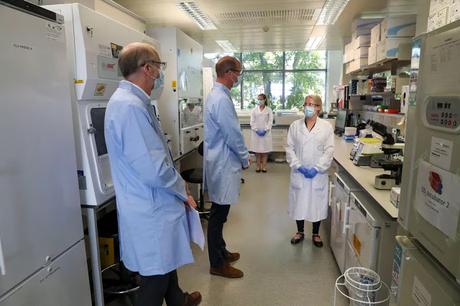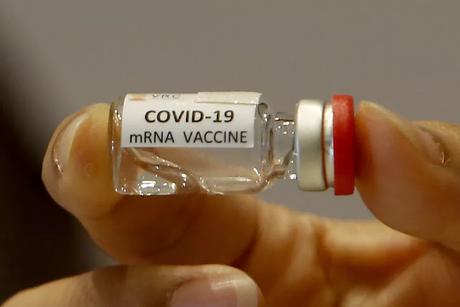How the newest vaccines fight Covid-19

In March of 1963, Dr. Maurice Hilleman was woken up one night by his 5-year-old daughter. She was complaining of a sore throat. So Hilleman looked her over and determined she had the mumps. Unable to sleep, he was struck with an idea. He swabbed her throat for a sample, drove to the lab, and got to work. Four years later ... his mumps vaccine was approved. It was the fastest a vaccine had ever been developed. Until now.
In 2020, vaccines for Covid-19 shattered previous records, going from development to approval in a matter of months. That speed was driven by billions of dollars, and a global effort. But in some cases, it was also because of a breakthrough in vaccine technology Something that could shrink this timeline going forward, and change how we make vaccines altogether. Vaccines teach your immune system how to respond to a threat.
How most older vaccines work
Traditionally, there have been four ways to do this. The two most common types of vaccines work by exposing you to a weakened or a dead version of a virus or bacteria. The weakened virus won’t make you sick, but it will teach your body how to fight the real thing if you’re exposed to it later on. This is how the measles and annual flu vaccines work.
Another, less common type of vaccine does a similar thing but uses an inert version of a toxin instead of a virus. The most well-known version of this is probably the tetanus shot. This fourth type of vaccine works a little differently because it only uses a small part of a virus instead of the whole thing. Common examples of this would be the Hepatitis B vaccine or the HPV vaccine.
The new Covid-19 vaccine platforms harness human cells to make key components
Some of the new Covid-19 vaccines also rely on these traditional methods. For example, one Covid-19 vaccine currently in trials uses this fourth method. It only uses one part of the SARs_CoV2 virus, known as the "spike protein." That spike protein is what allows the coronavirus to enter your cells.
When injected into your body on its own, it's harmless. But your body will still recognize it as a foreign threat, and launch an immune response to fight it off, which is enough to teach your body how to fight the whole virus. But isolating and preparing that spike protein for a vaccine is a process.
Researchers first had to modify it, then multiply it - a lot, and then assemble the vaccine itself in a lab. In fact, one thing that all four of these types of vaccines have in common is that they all require growing and transporting large amounts of live pathogens in a lab. And that takes a lot of time.
A vaccine goes through many steps before it can be approved, but before anything else, it has to be developed. And working with live pathogens makes that process a lot longer. On average, it takes 5 to 10 years for a vaccine to reach FDA approval in the United States.
Most Covid-19 vaccines have gotten through this process a lot faster by overlapping the different phases of human trials, and by starting the manufacturing early, But some vaccines have also found a groundbreaking way to speed up this first section - by shifting some of the work out of the lab, and into your body.
How mRNA vaccines work

Nearly every function in the human body is carried out by proteins. So our cells are constantly manufacturing them. To do that, they make a single-stranded copy of DNA. That copy is called messenger RNA, or mRNA.
Each strand of mRNA holds the information on how to make one type of protein. The cell reads the mRNA, follows the instructions, and makes a protein. they contain instructions. Researchers who developed these new vaccines, called mRNA vaccines, started with the genetic sequence of the virus.
They also decided to focus on the spike protein we talked about earlier. But instead of assembling and purifying that protein in a lab, they identified the part of the genetic sequence that creates it - and then took a much faster route, by synthesizing mRNA, and using that as the vaccine, which saved months of time and money.
Once it's inside the body, the cell reads the mRNA and begins to make harmless spike proteins of its own. From there, your body’s immune system recognizes the foreign threat and sounds the alarm. This is how the new Covid-19 vaccines from Pfizer-BioNTech and Moderna work.
But the main drawback with an mRNA vaccine is that mRNA breaks down very easily. It has to be delivered inside a protective fatty barrier and kept ultracold, which isn’t super ideal for a vaccine that needs to reach all areas of the globe.
Another effective new-to-consumer kind of vaccine works similarly but uses DNA instead of mRNA, which is much more stable. The Covid-19 vaccines from AstraZeneca and Johnson & Johnson are this type. It doesn’t require ultra-cold conditions.
To get the DNA into your cells, researchers use a harmless virus as a carrier. But over time, your body will build resistance to that virus, which means future doses using this carrier will become less and less effective, and the carrier will need to be updated.
But in terms of efficacy, costs, and speed, these two new vaccine types have broken records. These new vaccines are a groundbreaking way to elicit an immune response. And while they’ll have a big impact on how we fight Covid-19.
A vaccine that delivers specific instructions to your body opens up a whole new world of vaccine technologies and disease treatments, for things like cancer or HIV. Finding a vaccine was a turning point for the pandemic. But the pandemic might also be a turning point for vaccine
Source and Photos Credit: vox.com
